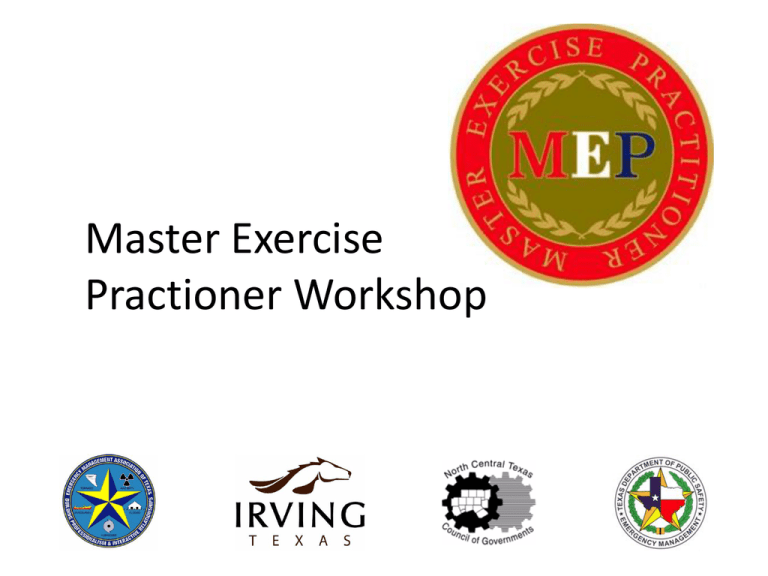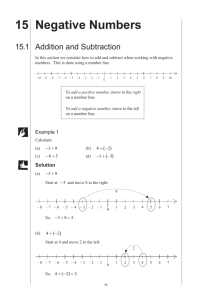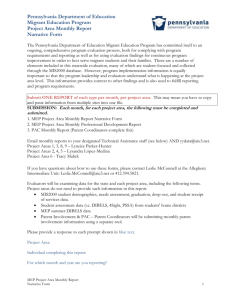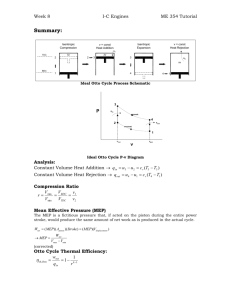Master Exercise Practioner Workshop
advertisement

Master Exercise Practioner Workshop Agenda • • • • Introductions and recognition of MEPs Why MEP? MEP Program Overview E/G-131 Exercise Evaluation & Improvement Planning Course – Review • Q&A Presenters • • • • • Patrick McMacken, CEM, TEM, MEP EMC City of Irving Chair NCT Exercise & Training Committee pmcmacken@cityofirving.org 972-721-2100 • Esther Corwin, MEP • Texas Division of Emergency Management, Exercise Unit, Exercise Training Officer • esther.corwin@dps.texas.gov • 512-424-2198 MEP Introductions • If you have completed or are enrolled in the Master Exercise Practitioner Program, please introduce yourself – Name – Jurisdiction Why MEPP? • Why should one become a Master Exercise Practitioner? – Better exercise quality – Improved outcomes – Increased professionalism MEP Program Overview • To improve the capabilities of emergency management exercise personnel in exercise program management and in every phase of the exercise process. By improving the knowledge, skills, and abilities, both the quantity and quality of exercises can be improved • Created in 1999 as a non-resident program to recognize those individuals who completed prescribed training and demonstrated, through hands-on application, a high degree of professionalism and capability in exercises • In 2004, EMI began offering this title certificate program in a resident series of courses at the NETC in Emmitsburg, Maryland MEP Program Overview Target Audience Training Prerequisites • Exercise training officers • Emergency managers • Emergency services personnel • IS-100.b, Introduction to ICS • IS-120.a, An Introduction to Exercises • IS-130, Exercise Evaluation and Improvement Planning • IS-200.b, ICS for Single Resources and Initial Action Incidents • IS-230.a, Fundamentals of Emergency Management • IS-235, Emergency Planning • IS-700.a, NIMS, An Introduction • IS-775, EOC Management and Operations • IS-800.b, NRF, An Introduction – – – – – – – Fire Emergency Medical and Hospitals Public and Environmental Health Coroners Law enforcement Public Works and Utilities Community Service and Volunteer agencies – Private entities • Local, Tribal, State, Territorial, and other Federal agency personnel G-131 & E/L-131: Exercise Evaluation and Improvement Planning Unit 1: Exercise Evaluation Overview Importance of Exercise Evaluation & Improvement Planning • Exercise evaluation – Assesses a jurisdiction or organization's performance by identifying strengths and areas for improvement • Improvement planning – Leverages the outputs of the evaluation process by developing Improvement Plans (IPs) – Provides a disciplined process for implementing corrective actions and socializing best practices Course Goal • To familiarize individuals with exercise planning or evaluation responsibilities with the Homeland Security Exercise Evaluation Program’s (HSEEP) exercise evaluation and improvement planning process, and to provide those students opportunities to practice key exercise evaluation skills. Course Objectives (1 of 2) • Describe the need for a systematic approach to exercise evaluation • List the eight steps of the exercise evaluation and improvement planning process • Identify pre-exercise activities necessary for a successful evaluation • Explain the function of Exercise Evaluation Guides and their relationship to the Target Capabilities List /Universal Task List Course Objectives (2 of 2) – Practice evaluation observation, data analysis, and report writing skills – Describe post-exercise analysis activities – Explain the purpose and format of the After Action Report/Improvement Plan (AAR/IP) – Describe how a Corrective Action Program (CAP) translates exercise outcomes into continual improvements to preparedness Course Structure (1 of 2) – Unit 1: Exercise Evaluation Overview – Unit 2: Exercise Evaluation Process – Unit 3: Planning and Organizing the Evaluation – Unit 4: Observing the Exercise and Collecting Data – Unit 5: Analyzing Data – Unit 6: After Action Report and After Action Conference – Unit 7: The Corrective Action Program Course Structure (2 of 2) – Unit 8: Introduction to Evaluator Skill Practice – Unit 9: Customizing EEGs from TCLs and Objectives – Unit 10: Exercise Evaluation: Skill Practice #1 – Unit 11: Exercise Evaluation: Skill Practice #2 – Unit 12: Exercise Evaluation: Skill Practice #3 – Unit 13: Exercise Evaluation: Skill Practice #4 – Unit 14: Course Summary Exercise Training with TDEM • G-920, Texas Exercise Design and Evaluation – Provides students the opportunity to “learn by doing” each step of the design process creating a functional exercise to be conducted in class • L-146, HSEEP Training – DHS/FEMA developed this intermediate-level training course that incorporates exercise guidance and best practices from the HSEEP Volumes • www.PreparingTexas.org Texas MEP Networking • http://training.fema.gov/emiweb/emiopt.asp • Texas Division of Emergency Management 5805 N. Lamar PO BOX 4087 Austin, Texas 78773-0220 (512) 424-2138 (512) 424-2444 or 7160 FAX www.txdps.state.tx.us/dem/











